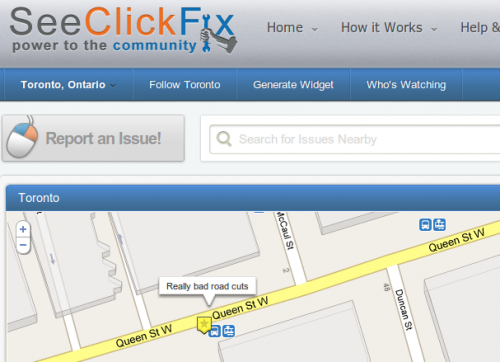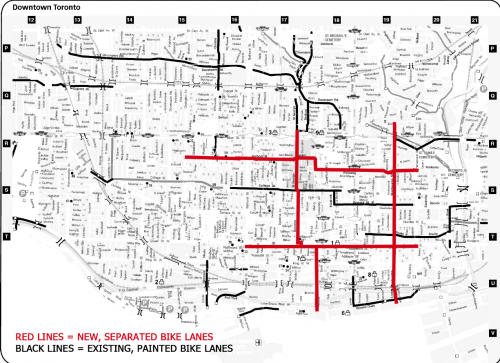Like me, perhaps you are wondering why a right-wing politician who had helped to push the "war on the car" meme on the public, had opposed separated bike lanes on University Ave and opposed the Jarvis bike lanes, is now supporting a separated bike lane network for downtown Toronto. It may help to get a bit more of the background.
Alan Heisey pointed out in my previous post that the Toronto Star map and information is incorrect. Heisey's original proposal, which looked like the map attached, also included separated bike lanes to Bathurst and Parliament on Harbord and on Richmond as well as bike lanes extended north of Bloor.
By email Heisey clarified some of the background of this story. Way back in January 2010, Heisey had proposed separating Sherbourne street bike lanes. TCAC (Toronto Cycling Advisory Committee) and Councillor McConnel endorsed it. Back in March 2010, Heisey returned with a petition to separate the lanes on St. George and Beverly. Around this time the City was voting on the University separated bike lanes, but which were narrowly defeated because of a voting error by McConnell. Minnan-Wong hated the idea of bike lanes on University so he proposed Heisey's plan as an alternative before Council. His proposal opposed by a majority of council.
In August, Heisey presented a petition to the public works committee (PWIC) for the entire plan (as pictured above). Councillors de Baeremaker, Heaps of PWIC support the plan. Councillors Perks and Carroll opposed it. Vaughan visits PWIC and opposes it. Minnan-Wong also visits PWIC and supports it. This is the first time that the Toronto Cyclists Union officially supports the network minus the St. George/Beverly separated lanes (though they have changed their position since to include it as well). PWIC decided to have staff report on the network for early 2011.
During the last couple weeks of the municipal election former mayoral candidate Rocco Rossi adopted the entire plan (the map above comes from his website), though his support was conditional on taking out the bike lanes on Jarvis.
According to Heisey, Minnan-Wong was quoted in the media last spring saying he supported snow removal for this core network. This would be critical for separated bike lanes since regular snow plows might not be able to do the job.
I've got lots of questions remaining. If cyclists buy into Minnan-Wong plan does it mean giving up on bike lanes on University and Jarvis? Or give up on the rest of the Bike Plan entirely? Is the bike union now supporting this plan because it will now be even harder to get bike lanes on University?
Heisey's heart is in the right place, but this plan has had much more sympathy on the right than the left for reasons I can only speculate about. During this time the left-leaning politicians were pushing University Ave bike lanes. And we just got Jarvis. Strategically we might lose both of these streets, which would mean less kilometres of bike lanes total (aside from Richmond) in exchange for reconfigured lanes elsewhere. But we also might gain quite a bit, since separated bike lanes, wherever they go in, may result in a significant culture shift and increase the visibility of cyclists.
At this point the biggest barriers to accomplishing this plan comes from Ford's unthinking ideology that is only willing to count people in cars as "traffic" and from Councillor Vaughan who has plans for two way traffic on Richmond and Adelaide which would preclude bike lanes. Vaughan had also opposed separated bike lanes on St. George/Beverly in the media recently, though a bird told me that at some point Vaughan was actually asking staff to investigate such a plan.
Such is the moving target that is politics, that may or may not involve good planning decisions. But at least some of them are taking cyclists seriously.


